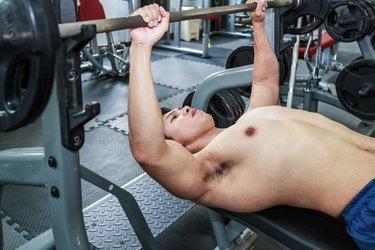
Listen up, skinny lads! Is your inner muscle-man screaming to get out? Do you yearn for a manly chest but can't seem to put on bulk no matter what? Well, there is hope.
Yes, it's harder for some fellows than others to develop those robust chest muscles and swaggering V-like profile. But with the right combination of diet and resistance exercises along with some basic understanding of how muscle is built, you'll soon be king at Muscle Beach. Or at least you'll be cutting a stronger, more confident stature.
Video of the Day
Video of the Day
Read more: The 6 Rules of Gaining Muscle Mass
Eating for Ectomorphs
If you're tall, have long legs and arms and a slight build with thin bones, you're probably an ectomorph according to the American Council on Exercise (ACE). This body type tends to have a flat chest and not a lot of padding in and around the trunk. While they may look skinny, ectomorphs may actually have lots more body fat than meets the eye.
It's hard for ectomorphs to put on muscle mass because their humming-bird metabolisms burn calories incredibly quickly. Fitness pros call ectomorphs "hardgainers." To put on muscle mass, you'll be lifting weights.
That breaks down proteins in your muscles, so when you're trying to build it's important to consume more protein than you use up. Your body needs it for the repair work.
The same goes for calories. Adding muscle means gaining weight, so consume from 300 to 500 more calories than it takes to maintain your current body weight. High-calorie foods rich in nutrients like nuts and nut butter are recommended.
It's a good idea to eat before you work out. To avoid losing caloric ground, consume some carbs and protein such as toast or fruit with nut butter or jam a half hour to an hour prior to your workout.
While turning to powdered supplements such as whey may be tempting, the American Dietetic Association recommends getting your protein from dietary sources like meat, fish and poultry.
Chest Workout for Skinny Guys
Now let's convert that fuel into muscle. Yes, of course you want to build those chest muscles — the pectorals. In a 2012 study of the best chest exercises, ACE rated the top three as the barbell bench press, the pec deck machine and bent-forward cable cross-overs. It's good to periodically rotate the exercises because not all pec exercises use the muscles in the same way.
But as common sense might suggest, you probably want some other muscles to balance out your new-found chest full of muscle. Shoulders, perhaps? Really, you want well-defined shoulders to help balance out a muscular chest. Dumbbell shoulder press, 45-degree incline row and the seated rear lateral raise should get you off to a nice start.
And finally, no newly muscled bod would be aesthetically balanced without some work on those latissmus dorsi, otherwise known as "lats." They're the big flat muscles below the shoulder blades that make your shoulders look bigger and your chest look wider. For starters try the cable pulldown, says ExRx.net.
Reps and Sets
The body grows muscle fiber in response to muscle injury. Muscle fibers form to repair and rebuild those damaged by tiny little tears in the tissue when you work out, especially with weights. The key to getting into muscle-building mode, otherwise known as "hypertrophy," is to work with heavier weights that cause temporary muscle fatigue after six to 12 reps.
How much weight that is, of course, depends on the condition you're in when you're starting, so you'll have to experiment. As you progress, you'll need to up the amount of weight to keep getting results. Reaching temporary muscle fatigue — the point at which you can't do another rep — is crucial to gaining muscle mass.
When the goal is to build muscle, ACE recommends three to six sets of six to 10 reps with rest intervals of two to three minutes in between. Start with one or two sets at a weight that brings you to fatigue. Being a little sore is good, but not so sore that it doesn't wear off in a day or so.
Be sure to warm up the muscles with some aerobic activity to warm up the muscles you'll be using with weight lifting, followed by some stretching. This will help prevent injury and raise your metabolic rate so oxygen gets to your muscles more quickly. With high intensity training, you might start with three exercises per muscle group and work your way up to six.
Read more: How to Increase Arm and Chest Size Fast
Splitting the Difference
Building muscle requires recovery time. How much? The ideal is to work at a level intensity that allows you to work out every other day. If you've got the time to work out every day, then try split routines.
That means going all out with your chest, arm and upper body exercises one day, then do core and leg exercises the next. Otherwise, do a whole body routine every other day, giving yourself 48 hours in between workouts.
Opposing super sets are another approach. This involves working on a pair of opposing muscles, such as chest and back, or biceps and triceps, then alternating between the two with minimal rest in between sets.
Finally, be sure to get plenty of sleep. Because muscle tissue is actually built during recovery, getting plenty of rest is highly important.
- ACE Fitness: "How to Eat and Train for an Ectomorph Body Type"
- ACE Fitness: "ACE-Sponsored Research: Top 3 Most Effective Chest Exercises"
- ACE Fitness: "7 Techniques for Promoting Muscle Growth"
- ACE Fitness: "The Do's and Don'ts of Building Muscle"
- ACE Fitness: "20-Minute Opposing Super Set Workout"
- ExRx.net: "Cable Pulldown"
- ACE Fitness: "How Many Reps Should You Be Doing?"
Was this article helpful?
150 Characters Max
0/150
Thank you for sharing!
Thank you for your feedback!